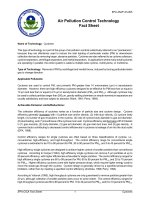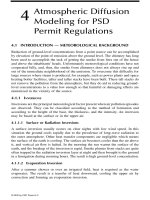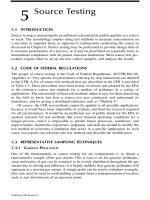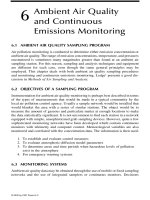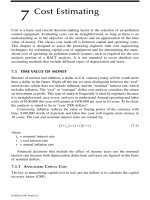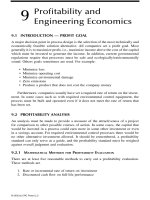AIR POLLUTION CONTROL TECHNOLOGY HANDBOOK - CHAPTER 4 docx
Bạn đang xem bản rút gọn của tài liệu. Xem và tải ngay bản đầy đủ của tài liệu tại đây (177.64 KB, 13 trang )
Atmospheric Diffusion
Modeling for PSD
Permit Regulations
4.1 INTRODUCTION — METEOROLOGICAL BACKGROUND
Reduction of ground-level concentrations from a point source can be accomplished
by elevation of the point of emission above the ground level. The chimney has long
been used to accomplish the task of getting the smoke from fires out of the house
and above the inhabitants’ heads. Unfortunately meteorological conditions have not
cooperated fully, and, thus, the smoke from chimneys does not always rise up and
out of the immediate neighborhood of the emission. To overcome this difficulty for
large sources where steam is produced, for example, such as power plants and space
heating boiler facilities, taller and taller stacks have been built. These tall stacks do
not remove the pollution from the atmosphere, but they do aid in reducing ground-
level concentrations to a value low enough so that harmful or damaging effects are
minimized in the vicinity of the source.
4.1.1 I
NVERSIONS
Inversions are the principal meteorological factor present when air pollution episodes
are observed. They can be classified according to the method of formation and
according to the height of the base, the thickness, and the intensity. An inversion
may be based at the surface or in the upper air.
4.1.1.1 Surface or Radiation Inversions
A surface inversion usually occurs on clear nights with low wind speed. In this
situation the ground cools rapidly due to the prevalence of long-wave radiation to
the outer atmosphere. Other heat transfer components are negligible which means
the surface of the earth is cooling. The surface air becomes cooler than the air above
it, and vertical air flow is halted. In the morning the sun warms the surface of the
earth, and the breakup of the inversion is rapid. Smoke plumes from stacks are quite
often trapped in the radiation inversion layer at night and then brought to the ground
in a fumigation during morning hours. The result is high ground-level concentration.
4.1.1.2 Evaporation Inversion
After a summer shower or over an irrigated field, heat is required as the water
evaporates. The result is a transfer of heat downward, cooling the upper air by
convection and forming an evaporation inversion.
4
9588ch04 frame Page 45 Wednesday, September 5, 2001 9:44 PM
© 2002 by CRC Press LLC
4.1.1.3 Advection Inversion
An advection inversion forms when warm air blows across a cooler surface. The
cooling of the air may be sufficient to produce fog. When a sea breeze occurs from
open water to land, an inversion may move inland, and a continuous fumigation
may occur during the daytime.
4.1.1.4 Subsidence Inversion
In Los Angeles, the typical inversion is based in the upper air. This inversion results
from an almost permanent high pressure area centered over the north Pacific Ocean
near the city. The axis of this high is inclined in such a way that air reaching the
California coast is slowly descending or subsiding. During the subsidence, the air
compresses and becomes warmer, forming an upper-air inversion. As the cooler sea
breeze blows over the surface, the temperature difference increases, and the inversion
is intensified. It might be expected that the sea breeze would break up the inversion
but this is not the case. The sea breeze serves only to raise and lower the altitude
of the upper air inversion.
4.1.2 T
HE
D
IURNAL
C
YCLE
On top of the general circulation a daily, or 24-hour cycle, referred to as the diurnal
cycle is superimposed. The diurnal cycle is highly influenced by radiation from the
sun. When the sun appears in the morning, it heats the earth by radiation, and the
surface of the earth becomes warmer than the air above it. This causes the air
immediately next to the earth to be warmed by convection. The warmer air tends to
rise and creates thermal convection currents in the atmosphere. These are the ther-
mals which birds and glider pilots seek out, and which allow them to soar and rise
to great altitudes in the sky.
On a clear night, a process occurs which is the reverse of that described above.
The ground radiates its heat to the blackness of space, so that the ground cools off
faster than the air. Convection heat transfer between the lower air layer and the
ground causes the air close to the ground to become cooler than the air above, and
a radiation inversion forms. Energy lost by the surface air is only slowly replaced,
and a calm may develop.
These convection currents set up by the effect of radiant heat from the sun tend
to add or subtract from the longer-term mixing turbulence created by the weather
fronts. Thus, the wind we are most familiar with, the wind close to the earth’s surface,
tends to increase in the daytime and to die down at night.
There are significant diurnal differences in the temperature profiles encountered
in a rural atmosphere and those in an urban atmosphere. On a clear sunny day in
rural areas, a late afternoon normal but smooth temperature profile with temperatures
decreasing with altitude usually develops. As the sun goes down, the ground begins
to radiate heat to the outer atmosphere, and a radiation inversion begins to build up
near the ground. Finally by late evening, a dog-leg shaped inversion is firmly
established and remains until the sun rises in the early morning. As the sun begins
to warm the ground, the inversion is broken from the ground up, and the temperature
9588ch04 frame Page 46 Wednesday, September 5, 2001 9:44 PM
© 2002 by CRC Press LLC
profile becomes “z” shaped. Smoke plumes emitted into the atmosphere under the
late evening inversion tend to become trapped. Since vertical mixing is very poor,
these plumes remain contained in very well-defined layers and can be readily
observed as they meander downwind in what is called a fanning fashion. In the early
morning as the inversion breaks up, the top of the thickening normally negative
temperature gradient will encounter the bottom edge of the fanning plume. Since
vertical mixing is steadily increasing under this temperature profile, the bottom of
the fanning plume suddenly encounters a layer of air in which mixing is relatively
good. The plume can then be drawn down to the ground in a fumigation which
imposes high ground-level concentrations on the affected countryside.
A similar action is encountered in the city. However, in this case, due to the
nature of the surfaces and numbers of buildings, the city will hold in the daytime
heat, and thus the formation of the inversion is delayed in time. Furthermore, the
urban inversion will form in the upper atmosphere which loses heat to the outer
atmosphere faster than it can be supplied from the surfaces of the city. Thus, the
evening urban inversion tends to form in a band above the ground, thickening both
toward the outer atmosphere and toward the ground. Smoke plumes can be trapped
by this upper air radiation inversion, and high ground concentrations will be found
in the early morning urban fumigation.
4.1.3 P
RINCIPAL
S
MOKE
-P
LUME
M
ODELS
Even though the objective of air pollution control is to reduce all smoke emissions
to nearly invisible conditions, some visible plumes are likely to be with us for quite
a long while. Visible plumes are excellent indicators of stability conditions. Five
special models have been observed and classified by the following names:
1. Looping
2. Coning
3. Fanning
4. Fumigation
5. Lofting
All of these types of plumes can be seen with the naked eye. A recognition of these
conditions is helpful to the modeler and in gaining an additional understanding of
dispersion of pollutants.
In the section immediately preceding this one, the condition for fanning followed
by fumigation has been described. Lofting occurs under similar conditions to fumi-
gation. However, in this case the plume is trapped above the inversion layer where
upward convection is present. Therefore, the plume is lofted upwards with zero
ground-level concentration resulting. When the day is very sunny with some wind
blowing, radiation from the ground upward is very good. Strong convection currents
moving upward are produced. Under these conditions plumes tend to loop upwards
and then down to the ground in what are called looping plumes.
When the day is dark with steady relatively strong winds, the temperature profile
will be neutral so that the convection currents will be small. Under these conditions
the plume will proceed downwind spreading in a cone shape. Hence the name coning
9588ch04 frame Page 47 Wednesday, September 5, 2001 9:44 PM
© 2002 by CRC Press LLC
plume is applied. Under these conditions dispersion should most readily be described
by Gaussian models.
4.2 THE TALL STACK
The Tennessee Valley Authority (TVA) has pioneered the use of tall stacks in the
U.S. and has carried out extensive experiments, collected data, and determined the
design variables and mathematical models to predict minimum ground-level con-
centrations. The 170 ft stacks provided at the first large steam plant constructed by
TVA at Johnsonville, TN, in 1952 were soon found to be inadequate. These stacks
were then extended to 270 ft in 1955, and TVA stack height has crept upwards ever
since. As evidence, the large coal-fired power plant at Cumberland City, TN, has
two 1000-ft stacks, and the Kingston and Widows Creek Plants which each have a
1000-ft stack, topping the former tallest stacks at the Bull Run and Paradise plants
by 200 ft.
Ever since structural steel became plentiful and strong enough to carry extreme
loads, longer and taller structures have been built. Competition in this area is keen,
and one wonders whether stack structures grow out of a rational need to reduce
ground-level concentrations, or out of man’s need to excel. Whatever the reason, it
is amusing to compile and contemplate the statistics on tall structures, as listed in
Table 4.1. Table 4.2 has the details of the TVA stacks at their major steam plants.
4.3 CLASSIFYING SOURCES BY METHOD OF EMISSION
Table 4.3 summarizes useful methods by which air pollution sources can be classi-
fied. Dispersion models exist which fit into this scheme. For stationary sources three
cases are defined: area sources, process stacks, and tall stacks.
4.3.1 A D
EFINITION
OF
T
ALL
S
TACKS
Adopting the TVA viewpoint to define a tall stack requires reference to the amount
of furnace heat input which should be greater than 293 MW (10
9
BTU/h). A furnace
TABLE 4.1
The Size of Tall Things
Sears Tower 1450 ft INCO Stack (Sudbury, ON) 1250 ft
World Trade Center 1350 ft Kennecott Company (Magna, UT) 1215 ft
Empire State Building
(1475 ft to top of mast)
1250 ft Penn Electric Company New York State Electric Co.
(Homer City, PA)
1210 ft
Chrysler Tower 1040 ft American Electric Power Mitchell Plant (Cresap, WV) 1206 ft
Eiffel Tower 984 ft Keystone Group (Conamaugh, PA) 1000 ft
Gateway Arch 630 ft TVA-Cumberland Plant 1000 ft
Washington Monument 555 ft TVA-Widows Creek Plant 1000 ft
TVA-Kingston Plant 1000 ft
9588ch04 frame Page 48 Wednesday, September 5, 2001 9:44 PM
© 2002 by CRC Press LLC
with this heat input would require 9072 kg/d (10,000 tons/d) of coal with a total
heating value of 27.89
×
10
10
J/kg (12,000 BTU/lb). A 100 MW plant would use
about 771 kg/d (850 tons/d) and could qualify as having a tall stack. Most tall stack
sources will be associated with fossil fuel burning steam electric power generating
facilities. Another method to identify a tall stack is through the heat emission rate.
This quantity should be greater than 20 MW (68.24
×
10
6
BTU/h) to define a tall
stack.
TABLE 4.2
Major TVA Steam Plants
Name
First Unit
in Operation
Unit
No.
Rated Capacity
Per Unit
(MW)
Total Plant
(MW)
Stacks
Number
Height
(ft)
Cumberland 1972 1–2 1300 2600 2 1000
Bull Run 1967 1 950 950 1 800
Paradise 1963 1–2 704 2558 2 600
3 1150 1 800
Allen 1959 1–3 330 990 3 400
Gallatin 1956 1–2 300 1255 1 500
3–4 327.5 1 500
Colbert 1955 1–2 200 1397 2 300
3–4 223 2 300
5 550.5 1 500
John Sevier 1955 1–2 223 846 1 350
3–4 200 1 350
Kingston 1954 1–4 175 1700 2 1000
a
5–9 200
Shawnee 1953 1 150 1750 2 800
b
2–7 175
8 150
9 175
10 150
Widows Creek 1952 1–2 140.6 1978 1 1000
c
3 150
4,5,6 140.6
7 575 1 500
8 550 1 500
Johnsonville 1951 1–4 125 1485 4 270
d
5–6 147 2 270
d
7–10 173 2 400
Watts Bar 1942 1–4 60 240 4 177
a
Original heights units 1–4, 250 ft, units 5–9, 300 ft.
b
Replaces ten 250 ft stacks.
c
Original six stacks 170 ft high, raised to 270 ft, then replaced.
d
Original height 170 ft.
9588ch04 frame Page 49 Wednesday, September 5, 2001 9:44 PM
© 2002 by CRC Press LLC
Heat input is not the only requirement for establishing a tall stack. Such stacks
produce plumes with great buoyancy, and these plumes have a high plume rise after
leaving the stack. Furthermore, the exit velocity is high enough to avoid any building
downwash. Rules of thumb to estimate the required exit velocity and stack height are
TABLE 4.3
Classifying Air Pollution Sources by Method of Emission
Moving Sources
Transportation Using Fossil Fuel
Internal combustion engine
Jet engine
Steam engine
Stationary Sources
Area Based
Low-Level Urban Sources
Result of space heating and trash burning
Homes, apartments, commercial buildings
Improper firing of furnaces, poor quality coal, uncontrolled emission
Models: Require extensive source-emission information
Process Stacks
Chemical and Petroleum Processing
Space heating and process steam
May be result of leak or venting waste inorganic or organic gases
Heights up to about 250 ft
Low buoyancy, high velocity — could be a pure jet emission — plume rise not great
Model: Gaussian, but must evaluate the effects of stack and building downwash and surrounding
topographical features
Tall Stacks
Fossil Fuel Burning for Electrical Power Production
Heights up to 1250 ft
High buoyancy and velocity
Plume rise significant
Furnace heat input: 10
9
BTU/h (100 MW plant and larger)
Heat emission rate: 19,000 BTU/s
Stack height: 2.5 times height of tallest structure near stack
Stack velocity: 1.5 times maximum average wind speed expected
Model: Gaussian, maximum concentration encountered depends upon regional meteorological
conditions and topographical features
hh
vu
s
b
s
>
>
25
15
.
.
9588ch04 frame Page 50 Wednesday, September 5, 2001 9:44 PM
© 2002 by CRC Press LLC
where
h
s
= height of stack
v
s
= stack exit velocity
h
b
= height of tallest structure near stack
–
u = maximum average wind speed that will be encountered
When a stack satisfies all these conditions, it may be considered a tall stack,
and calculations are simplified.
4.3.2 P
ROCESS
S
TACKS
All other point sources differ in several ways. Most process stacks are not connected
to sources with a high furnace heat input. Thus buoyancy is limited, and plume rise
may be smaller. Quite often these stack plumes will have a high velocity, but little
density difference, compared to ambient conditions. Thus the plumes might be
considered as jets into the atmosphere. Furthermore, since these stacks are usually
shorter than 400 ft, the plumes may be severely affected by the buildings and the
terrain that surround them. If stack efflux velocity is low, stack downwash may
become prominent. In general, this is the kind of stack that is found in a chemical
or a petroleum processing plant. Emissions from such a stack range from the usual
mixture of particulates, sulfur oxides, nitrogen oxides, and excess air to pure organic
and inorganic gases. To further complicate matters, these emissions usually occur
within a complex of multiple point emissions; the result being that single-point
source calculations are not valid. A technique for combining these process complex
sources must then be devised.
4.4 ATMOSPHERIC-DIFFUSION MODELS
An atmospheric-diffusion model is a mathematical expression relating the emission
of material into the atmosphere to the downwind ambient concentration of the
material. The heart of the matter is to estimate the concentration of a pollutant at a
particular receptor point by calculating from some basic information about the source
of the pollutant and the meteorological conditions. For a detailed discussion of the
models and their use, refer to the texts by Turner
1
and Schnelle and Dey.
2
Deterministic, statistically regressive, stochastic models and physical representa-
tions in water tanks and wind tunnels have been developed. Solutions to the deter-
ministic models have been analytical and numerical, but the complexities of analytical
solution are so great that only a few relatively simple cases have been solved.
Numerical solutions of the more complex situations have been carried out but require
a great amount of computer time. Progress appears to be the most likely for the
deterministic models. However, for the present, the stochastically based Gaussian-
type model is the most useful in modeling for regulatory control of pollutants.
Algorithms based on the Gaussian model form the basis of models developed for
short averaging times of 24 hours or less and for long-time averages up to a year.
The short-term algorithms require hourly meteorological data, while the long-term
algorithms require meteorological data in a frequency distribution form. Algorithms
9588ch04 frame Page 51 Wednesday, September 5, 2001 9:44 PM
© 2002 by CRC Press LLC
are available for single and multiple sources as well as single and multiple receptor
situations. On a geographical scale, effective algorithms have been devised for
distances up to 10 to 20 km for both urban and rural situations. Long-range algo-
rithms are available but are not as effective as those for the shorter distance. Based
on a combination of these conditions, the Gaussian plume model can provide at a
receptor either
1. The concentration of an air pollutant averaged over time and/or space, or
2. A cumulative frequency distribution of concentration exceeded during a
selected time period
4.4.1 O
THER
U
SES
OF
A
TMOSPHERIC
-D
IFFUSION
M
ODELS
Atmospheric-diffusion models have been put to a variety of scientific and regulatory
uses. Primarily the models are used to estimate the atmospheric concentration field
in the absence of monitored data. In this case, the model can be a part of an alert
system serving to signal when air pollution potential is high, requiring interaction
between control agencies and emitters. The models can serve to locate areas of
expected high concentration for correlation with health effects. Real-time models
can serve to guide officials in cases of nuclear or industrial accidents or chemical
spills. Here the direction of the spreading cloud and areas of critical concentration
can be calculated. After an accident, models can be used in
a posteriori
analysis to
initiate control improvements. The models also can be used for
• Stack-design studies
• Combustion-source permit applications
• Regulatory variance evaluation
• Monitoring-network design
• Control strategy evaluation for state implementation plans
• Fuel (e.g., coal) conversion studies
• Control-technology evaluation
• New-source review
A current frequent use for atmospheric-diffusion models is in air-quality impact
analysis. The models serve as the heart of the plan for new-source reviews and the
prevention of significant deterioration of air quality (PSD). Here the models are used
to calculate the amount of emission control required to meet ambient air quality
standards. The models can be employed in preconstruction evaluation of sites for
the location of new industries. Models have also been used in monitoring-network
design and control-technology evaluation.
4.5 EPA COMPUTER PROGRAMS FOR REGULATION
OF INDUSTRY
The EPA has developed a series of atmospheric-dispersion programs available
through the Support Center for Regulatory Air Models (SCRAM), now on the Web.
9588ch04 frame Page 52 Wednesday, September 5, 2001 9:44 PM
© 2002 by CRC Press LLC
Models used for regulatory purposes were initially made available through the Users
Network of Applied Modeling of Air Pollution (UNAMAP) system in three ways:
(1) executable codes on EPA’s IBM mainframe at Research Triangle Park, (2) source
codes for the UNISYS UNIVAC computer and test data on a magnetic tape from
the National Technical Information Service (NTIS), or (3) source codes and test data
in packed form from EPA’s UNAMAP Bulletin Board Service (BBS). During the
summer of 1989, a new system for distribution was put in place. Source codes for
models used for regulatory purposes were made available from the SCRAM Bulletin
Board Service (SCRAM BBS) operated by EPA’s Office of Air Quality Planning
and Standards (OAQPS). Updating this service, the models and technical information
concerning their use are now available on the Web, at the OAQPS-established
Technology Transfer Network. SCRAM is now available under this network at:
http//www.epa.gov/scram001/main.htm.
Using these programs, it is possible to predict the ground-level concentrations
of a pollutant resulting from a source or a series of multiple sources. These predic-
tions are suitable evidence to submit to states when requesting a permit for new
plant construction. Of course, the evidence must show that no ambient air quality
standard set by the EPA is exceeded by the predicted concentration.
The basic dispersion model employed by the EPA SCRAM programs is the
Gaussian equation. Briggs plume-rise method and logarithmic wind speed–altitude
equations are also used in the algorithms comprising SCRAM. SCRAM requires
the source–receptor configuration to be placed in either a rectangular or polar-type
grid system. The rectangular system is keyed to the Universal Transverse Mercator
(UTM) grid system employed by the U.S. Geological Survey on its detailed land
contours maps. This grid is indicated on the maps by blue ticks spaced 1 km apart
running both North–South and East–West. Sources and receptors can be located in
reference to this grid system and the dispersion axis located from each source in
reference to each of the receptor grid points. The polar grid system is used in a
screening model to select worst meteorological conditions. If concentrations under
the worst conditions are high enough, a more detailed study is conducted using the
rectangular coordinate system. The location of the highest concentration then is
determined within 100 m on the rectangular grid.
Meteorological data is obtained from on-site measurement, if possible. If not,
data must be used from the nearest weather bureau station. This data can be obtained
from the National Weather Records Center in Asheville, NC. At the weather stations,
data is recorded every hour. However, since 1964 the center in Asheville only
digitizes the data every third hour. Thus air-quality impact analysis studies can
employ 1964 hourly data for short averaging time studies. However, some of the
SCRAM programs have meteorological data preprocessors which take the surface
data and daily upper air data from the Asheville center and produce an hourly record
of wind speed and direction, temperature, mixing-depth, and stability. The meteo-
rological data is used in the dispersion programs to calculate hourly averages which
are then further averaged to determine 3-hour, 8-hour, etc. up to 24-hour averages.
Long-term modeling for monthly, seasonal, or annual averages require use of the
same data and a special program known as STAR, for Stability Array. This program
will compute an array of frequencies of occurrence of wind from the sixteen compass
9588ch04 frame Page 53 Wednesday, September 5, 2001 9:44 PM
© 2002 by CRC Press LLC
directions, in one of six wind speed classes, for either five, six, or seven stability
classes.
4.5.1 T
HE
I
NDUSTRIAL
S
OURCE
C
OMPLEX
M
ODEL
One of the most widely used models for estimating concentrations of nonreacting
pollutants within a 10 mile radius of the source is EPA’s Industrial Source Complex
Short-Term, Version 3 (ISCST3) program. It is a steady-state Gaussian plume model.
Therefore, the parameters such as meteorological conditions and emission rate are
constant throughout the calculation. There is also a long-term program, ISCLT. The
time periods for the short- term program include 1, 2, 3, 4, 6, 8, 12, and 24 h. The
ISCST3 program can calculate annual concentration if used with a year of sequential
hourly meteorological data.
The ISCLT is a sector-averaged model which combines basic features of several
older programs prepared for the EPA. It uses statistical wind summaries and calcu-
lates seasonal or annual ground-level concentrations. ISCLT accepts stack-, area-,
and volume-source types, and like the ISCST model, it uses the Gaussian-plume
model.
In both of these programs, the generalized plume-rise equations of Briggs, which
are common to most EPA dispersion models, are used. There are procedures to
evaluate effects of aerodynamic wakes and eddies formed by buildings and other
structures. A wind-profile law is used to adjust observed wind speed from measure-
ment height to emission height. Procedures from former models are used to account
for variations in terrain height over receptor grid. There are one rural and three urban
options which vary due to turbulent mixing and classification schemes. The models
make the following assumptions about plume behavior in elevated terrain:
• The plume axis remains at the plume stabilization height above mean sea
level as it passes over elevated or depressed terrain.
• Turbulent mixing depth is terrain following.
• The wind speed is a function of height above the surface.
• It truncates terrain at stack height if terrain height exceeds stack height.
4.5.2 S
CREENING
M
ODELS
In scenarios where there are few sources or emissions which are not very large, it
is usually advantageous to employ a screening model. For regulatory purposes, if
the concentrations predicted by the screening model exceed certain significant val-
ues, a more refined model must be employed. EPA’s SCREEN3 is available for this
screening operation. SCREEN3 allows a group of sources to be merged into one
source, and it can account for elevated terrain, building downwash, and wind speed
modifications for turbulence.
4.5.3 T
HE
N
EW
M
ODELS
CALPUFF, a multilayer, multispecies, nonsteady-state dispersion model that views
a plume as a series of puffs is a new model under consideration. This model simulates
9588ch04 frame Page 54 Wednesday, September 5, 2001 9:44 PM
© 2002 by CRC Press LLC
space–time, varying meteorological conditions on pollutant–transport, chemical
reaction, and removal. It can be applied from around 100 ft downwind up to several
hundreds of miles.
The American Meteorological Society/EPA Regulatory Model (AERMOD) is a
refined model currently under development by EPA as a supplement to ISCST3 for
regulatory purposes. By accounting for varying dispersion rates with height, refined
turbulence based on planetary boundary layer theory, advanced treatment of turbulent
mixing, plume height, and terrain effects, AERMOD improves the estimate of
downwind dispersion. AERMOD, along with AERMET, a meteorological data pre-
processor, and AERMAP, a terrain data preprocessor, are state-of-the-art air quality
models destined to become EPA’s regulatory model of choice.
A new version of the ISCST3 model known as ISC-PRIME has become avail-
able. This model incorporates plume-rise enhancements and the next generation of
building downwash effects. There are also a variety of specialized models for
accidental release modeling, roadway modeling, offshore sources, and regional trans-
port modeling.
4.6 THE SOURCE–TRANSPORT–RECEPTOR PROBLEM
The heart of the matter with which we are dealing is, given a source emitting a
pollutant, can we estimate, by calculation, the ambient concentration of that pollutant
at a given receptor point? To make the calculation, it is obvious that we must have
a well-defined source and that we must know the geographic relation between the
source and the receptor. But we must understand the means of transport between
the source and the receptor, as well. Thus source–transport–receptor becomes the
trilogy which we must quantitatively define in order to make the desired computation.
4.6.1 T
HE
S
OURCE
Defining the source is a difficult matter in most cases. We need to consider first
whether it is mobile or stationary and then whether it is emitted from a point, in a
line, or more generally from an area. Then we must determine its chemical and
physical properties. The properties can be determined most appropriately by sam-
pling and analysis, when possible. It is then that we turn, for example, to estimation
by a mass balance to determine the amount of material lost as pollutant. The major
factors that we need to know about the source are
1. Composition, concentration, and density
2. Velocity of emission
3. Temperature of emission
4. Pressure of emission
5. Diameter of emitting stack or pipe
6. Effective height of emission
From these data, we can calculate the flow rate of the total stream and of the
pollutant in question.
9588ch04 frame Page 55 Wednesday, September 5, 2001 9:44 PM
© 2002 by CRC Press LLC
4.6.2 T
RANSPORT
Understanding transport begins with three primary factors that affect the mixing
action of the atmosphere: radiation from the sun and its effect at the surface of the
earth, rotation of the earth, and the terrain or topography and the nature of the surface
itself. These factors are the subject of basic meteorology.
The way in which atmospheric characteristics affect the concentration of air
pollutants after they leave the source can be viewed in three stages:
1. Effective emission height
2. Bulk transport of the pollutants
3. Dispersion of the pollutants
4.6.2.1 The Effective Emission Height
After a hot or buoyant effluent leaves a properly designed source, such as a chimney,
it keeps on rising. The higher the plume goes, the lower will be the resultant ground-
level concentration. The momentum of the gases rising up the chimney initially
forces these gases into the atmosphere. This momentum is proportional to the stack
gas velocity. However, stack gas velocity cannot sustain the rise of the gases after
they leave the chimney and encounter the wind, which eventually will cause the
plume to bend over. Thus mean wind speed is a critical factor in determining plume
rise. As the upward plume momentum is spent, further plume rise is dependant upon
the plume density. Plumes that are heavier than air will tend to sink, while those
with a density less than that of air will continue to rise until the buoyancy effect is
spent. The buoyancy effect in hot plumes is usually the predominate mechanism.
When the atmospheric temperature increases with altitude, an inversion is said to
exist. Loss of plume buoyancy tends to occur more quickly in an inversion. Thus,
the plume may cease to rise at a lower altitude, and be trapped by the inversion.
Many formulas have been devised to relate the chimney and the meteorological
parameters to the plume rise. The most commonly used model, credited to Briggs,
will be discussed in a later section. The plume rise that is calculated from the model
is added to the actual height of the chimney and is termed the effective source height.
It is this height that is used in the concentration-prediction model.
4.6.2.2 Bulk Transport of the Pollutants
Pollutants travel downwind at the mean wind speed. Specification of the wind speed
must be based on data usually taken at weather stations separated by large distances.
Since wind velocity and direction are strongly affected by the surface conditions,
the nature of the surface, predominant topologic features such as hills and valleys,
and the presence of lake, rivers, and buildings, the exact path of pollutant flow is
difficult to determine. Furthermore, wind patterns vary in time, for example, from
day to night. The Gaussian concentration model does not take into account wind
speed variation with altitude, and only in a few cases are there algorithms to account
for the variation in topography. For the future, progress in modeling downwind
9588ch04 frame Page 56 Wednesday, September 5, 2001 9:44 PM
© 2002 by CRC Press LLC
concentrations will come through increased knowledge of wind fields and numerical
solutions of the deterministic models.
4.6.2.3 Dispersion of the Pollutants
Dispersion of the pollutant depends on the mean wind speed and atmospheric
turbulence. The dispersion of a plume from a continuous elevated source increases
with increasing surface roughness and with increasing upward convective air cur-
rents. Thus, a clear summer day produces the best meteorological conditions for
dispersion, and a cold winter morning with a strong inversion results in the worst
conditions for dispersion.
4.6.3 T
HE
R
ECEPTOR
In most cases, legislation will determine the ambient concentrations of pollutant to
which the receptor is limited. Air quality criteria delineate the effects of air pollution
and are scientifically determined dosage–response relationships. These relationships
specify the reaction of the receptor or the effects when the receptor is exposed to a
particular level of concentration for varying periods of time. Air quality standards
are based on air quality criteria and set forth the concentration for a given averaging
time. Regulations have been developed from air quality criteria and standards which
set the ambient quality limits. Thus the objective of our calculations will be to
determine if an emission will result in ambient concentrations which meet air quality
standards that have been set by reference to air quality criteria.
Usually, in addition to the receptor, the locus of the point of maximum concen-
tration, or the contour enclosing an area of maximum concentration, and the value
of the concentration associated with the locus or contour should be determined. The
short-time averages that are considered in regulations are usually 3 min, 15 min,
1 h, 3 h, or 24 h. Long-time averages are one week, one month, a season, or a year.
REFERENCES
1. Turner, D. B.,
A Workbook of Atmospheric Dispersion Estimates
, 2nd ed., Lewis
Publishers, CRC Press, Inc., Boca Raton, 1994.
2. Schnelle, Jr. K. B. and Dey, P. R.,
Atmospheric Dispersion Modeling Compliance
Guide
, McGraw-Hill, New York, 1999.
9588ch04 frame Page 57 Wednesday, September 5, 2001 9:44 PM
© 2002 by CRC Press LLC
